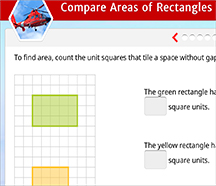Redbird Mathematics, the result of more than 25 years of research at Stanford University, is one of the most thorough online math programs for the elementary grades. Available for kindergarten through seventh grade, the program is geared for gifted students. The program is also great for average students even if they might need to work below their grade level. You will probably find that completing the K-7 program will prepare students to move very quickly through any pre-algebra course.
When you enroll a student you will choose a particular grade level, but that designation can be changed if need be. Bear in mind that if you switch the grade level, previous work is kept only in summarized form, and future reports reflect only work done at the new grade level.
This is an adaptive curriculum within any given grade level. According to the publisher, the courseware adapts based on a variety of inputs including right and wrong answers and the order of those responses. As students give more correct answers, it advances them more quickly (fewer questions and fewer review items). It won’t skip concepts, but it reduces the total number of questions if they are zooming through. If a student answers wrongly, it will show problems in a different way to instruct that concept using different modes of instruction. Then it will provide more practice material to ensure the student knows the material and concepts. In addition, if students already understand a concept, they can skim instructional material and move quickly through the lessons.
Lessons include instruction, examples, and guided practice before students try to apply concepts or skills on their own. Often included in lessons are word problems and real-world applications (sometimes with videos showing real-life applications) as well as digital manipulatives and simulation tools. If a student misses a problem, they are shown the correct answer with an explanation. The program tackles concepts from a number of directions, often presenting problems in a way that requires critical thinking along with computational skills. Overall, the program seems exceptionally good at developing conceptual understanding.
Beginning with second grade, students are also given an online, project-based learning activity. For example, second-grade students plan a 5-day mission to the moon, using addition and subtraction skills to build a rocket with enough food and water to support ten astronauts.
I did not have time to complete an entire level of the program for this review, but I had a five-year-old child and an eight-year-old child both try different levels of the program with great success and enthusiasm. They would work for quite a while in this program without getting bored since lessons continually change their format. Students aren’t stuck solving endless problems of the same sort before they can progress. The website says that there are more than 15,000 practice problems in the system, so there is plenty of practice without duplication. The only reason you might supplement would be to give students more paper-and-pencil practice with math computations.
Games incorporated into the program both teach and encourage students. The games require students to employ math skills and knowledge from current lessons but within unusual, fun, and challenging contexts. One game for young students requires them to build bridges in two stages before they can get their truck across the bridge. Another for older students mimics programming skills within a game format.
Projects and problems at all levels sometimes include mention of science, technology, engineering, and math (STEM) applications and careers. At the upper levels, videos and interviews with real-life professionals encourage students to start thinking about STEM careers.
From what I could see and experience with this program, students might need someone to be available to help them read through instructions or sort out unfamiliar lesson presentations. Every once in a while, I ran into a lesson presentation that wasn’t entirely clear about what needed to be done, but it was easy enough to figure it out. But that means that some students might be stumped from time to time and need someone on hand to assist them.
Summary
I am really impressed by the comprehensive and thorough quality of Redbird Mathematics. This seems to be one of the best online math programs available.
(Note that the Homeschool Buyers Club is probably the best source from which to subscribe.)









